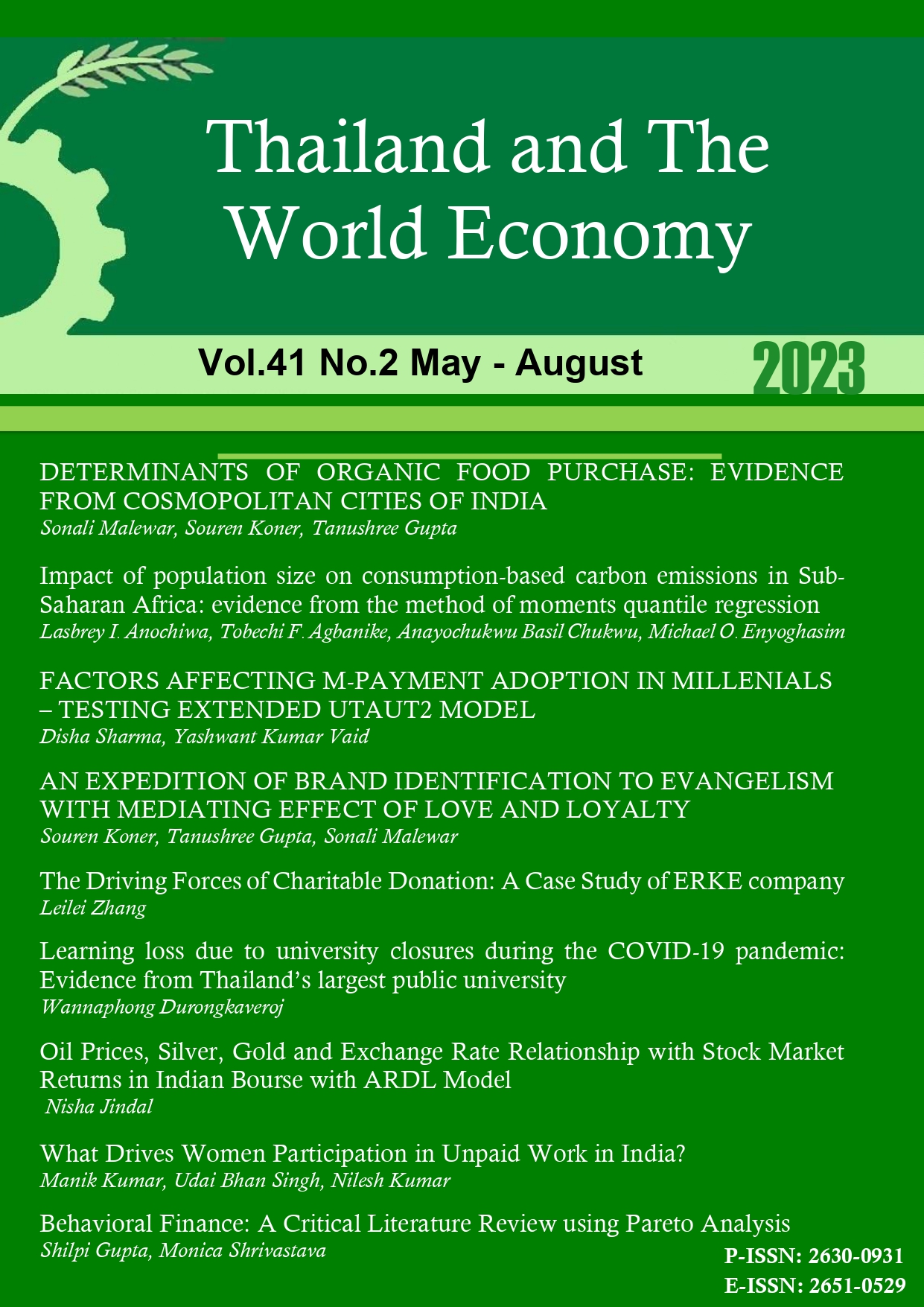The Driving Forces of Charitable Donation: A Case Study of ERKE company
Keywords:
Enterprise charity, driving force, transfer mechanism, natural disaster, corporate developmentAbstract
The paper, starting with the flood disaster that erupted in Henan in July 2021 and taking the enterprise charity practice of EREK as a single case research object, discusses why a bankrupt company can revive from charitable donation. The paper, putting forward the mechanism of enterprise charitable donation from outside to inside and drawing the view that “charitable donation can only raise corporate value when it is seen as a true expression of corporate social responsibility”, provides a case reference for promoting the sustainable development of corporate charity and enterprise strategic development by understanding the current connotation and market reaction, the charitable environment faced by enterprises, as well as the corporate charitable donation driving factor of Chinese enterprises in the face of major natural disasters.
References
Anderson, R. (2005). Philanthropy investment = good reputation? --How to develop corporate social responsibility projects more strategically [J]. International Mansion: International Observation, 6(4): 44-45
Basu, K., & Palazzo, G. (2009). Corporate social responsibility: A process model of sensemaking. Academy of Management Review,33(1),122-136.
Brahms, M . (2005). Profit Maximization vs. Agency: An Analysis of British Corporate Charitable Donations. Cambridge Journal of Economics, 29(04), 517-534.
Brownwall, Hyland, Smith. (2006). Corporate Charity Practice. Corporate Finance Journal, 12(05), 855-877.
Campbell., Gulas, C. S., & Gruca, T. (1999). Corporate giving behavior Decision-maker social consciousness. Journal Of Business Ethics, 19,375-383.
Carroll. (1991). Corporate Social Performance Measurement: A Comprehensive Structural Evaluation Method. Corporate Social Performance and Policy Research, 16 (04), 385-401.
Chen, Lu. (2019). Research on the Cancellation System of Charitable Donations of Bankrupt Enterprises. Xiamen University, China.
Dai, Yunhao., & Kong, Dongmin. (2014). Regaining attention from neglect: Analyst attention and corporate charitable donations. The Quarterly of Finance, 8(2),1-35.
Dyer, W. G., & Wilkins, A. L.(1991). Better stories, not better constructs, to generate better theory: A rejoinder to Eisenhardt. Academy of Management Review, 16(3),613-619.
Financial report, (2021). How did the once brilliant Hongxing Erke decline? The reason behind Hongxing Erke’s dismal business. Retrieved from
https://www.xianjichina.com/news/details_279933.html
Gardberg, N. A., & Formbrun, C. J. (2006). Corporate citizenship: Creating intangible assets across institutional environments. Academy of Management Review, 31(02), 329-346.
Yang, Tuan & Zhu Jiangang. (2021). Donation field: The basic path of multinational companies' network production. Retrieved from https://xianxiao.ssap.com.cn/bibliography/1879347.html.
Godfrey, P. C. (2005). The relationship between corporate philanthropy and shareholder wealth: A risk management perspective. Academy of Management Review, 30(04),777-798.
He, Qiang. (2014). Research on the impact of corporate charitable donations on brand value. Dalian University of Technology, China.
Liaoshen Evening News. (2021). 50 million was questioned as a fraudulent donation, Hongxing Erke “voiced. Retrieved from
https://baijiahao.baidu.com/s?id=1706258821074244889&wfr=spider&for=pc
Sina News. (2021). Hongxing Erke donated 50 million yuan, demonstrating corporate responsibility. Retrieved from
https://news.sina.cn/2021-07-25/detail-ikqciyzk7444583.d.html?vt=4.
I-yiou. (2021). After the floods in Henan, Chinese companies are in action: More than 70 companies have donated more than 2.1 billion in total. Retrieved from
https://www.iyiou.com/analysis/202107211020059.
Lev, B., Petrovits, C., & Radhakrishan, S. (2010). Is doing good for you? How corporate charitable contributions enhance revenue growth. Strategic Management Journal, 31(2), 182-200.
Li, Wei'an., & Hao, Chen. (2009). What are the standards of corporate social responsibility?-Reflections brought to us by Vanke’s disaster relief donations. Capital Market, 3(01), 111-113.
Li, Weixia.(2014). Driving Mechanism and Realization Path of Corporate Social Responsibility, Dalian: Dalian University of Technology, China.
Luo, Jiaqi., Li, Weixia., Kuang, Haibo., & Qi, Liyun. (2015). Research on Driving Factors of Corporate Social Responsibility Based on the Theory of Meaning Construction-Taking Shell Oil as an Example. Management Case Studies and Reviews, 8(5), 434-444.
Mai, sheng., Liang, min., & Su, Shuang. (2017). Research on the internal driving factors of corporate philanthropy-Taking Jiaduobao Group as an example. Management Case Studies and Reviews, 10(6),583-593.
Mode, D. M. (2008). Does the market value corporate philanthropy? Evidence of 2004 Tsunami Relief Effort. Journal of Business Ethics, 81(3), 599-607.
Pan, Yue., Weng, Ruoyu., & Liu, Siyi. (2017). Selfish Goodwill: New Evidence Based on Corporate Charitable Donations in Typhoon. China Industrial Economics, 19(5), 133-151.
Saiia, D. H., Carroll, A. B., & Buchholtz, A K. (2003). Philanthropy as strategy: When corporate charity “begins at home”. Business & Society, 42(2), 169-201.
Saiia, D. H. (2001). Corporate citizenship and corporate philanthropy: Strategic philanthropy is good corporate citizenship. Journal of Corporate Citizenship, 1(2),1-19.
Smith, C. (1994). The New Corporate Philanthropy. Harvard Business Review, 72(3), 105-116.
Song, Lin., & Wang, Jianling. (2010). The market response to corporate philanthropy in China-An empirical test based on the donation data of the Wenchuan earthquake. Contemporary Economic Science, 32(11), 6 - 32.
Tan, Guangyong. (2010). Some thoughts on how companies make charitable donations triggered by the Wenchuan earthquake. Market Weekly (Theoretical Research), 3(03), 74-76.
Wang, Duanxu., & Pan, Qi. (2011). Do corporate philanthropy papers bring value returns: An empirical study of listed companies with the satisfaction of stakeholders as the moderator. China Industrial Economics, 2(7), 118-128.
Wang, Yinchun. (2015). Introduction to charity ethics, Shanghai: Shanghai Jiaotong University Press. Is this a book? Author(s) of book – family name and initials, use & for multiple authors. (Year of publication). Title of book - italicised. Place of publication: Publisher.
Yang, Tuan., & Ge, Daoshun. (2009). China philanthropy development report. Beijing: Social Sciences Archives Press.
Zhang, Qiaozhen. (2014). A discussion on corporate charitable donation behavior and its driving force from outside to inside-Taking the donation behavior of Wenchuan earthquake as an example. Journal of Liming Vocational University, 6(1), 40-45.
Zhang, Ran. (2008). Interpretation of corporate social responsibility and governance structure of companies during the disaster. Inheritance, 2(7),126-127.
Zhang, R., Rezaee, Z., & Zhu, J.(2010). Corporate Philanthropic Disaster Response and Ownership Type: Evidence from Chinese Firms’ response to the Sichuan Earthquake. Journal of Business Ethics, 91(1), 51-63.
Downloads
Published
How to Cite
Issue
Section
License

This work is licensed under a Creative Commons Attribution-NonCommercial-NoDerivatives 4.0 International License.










